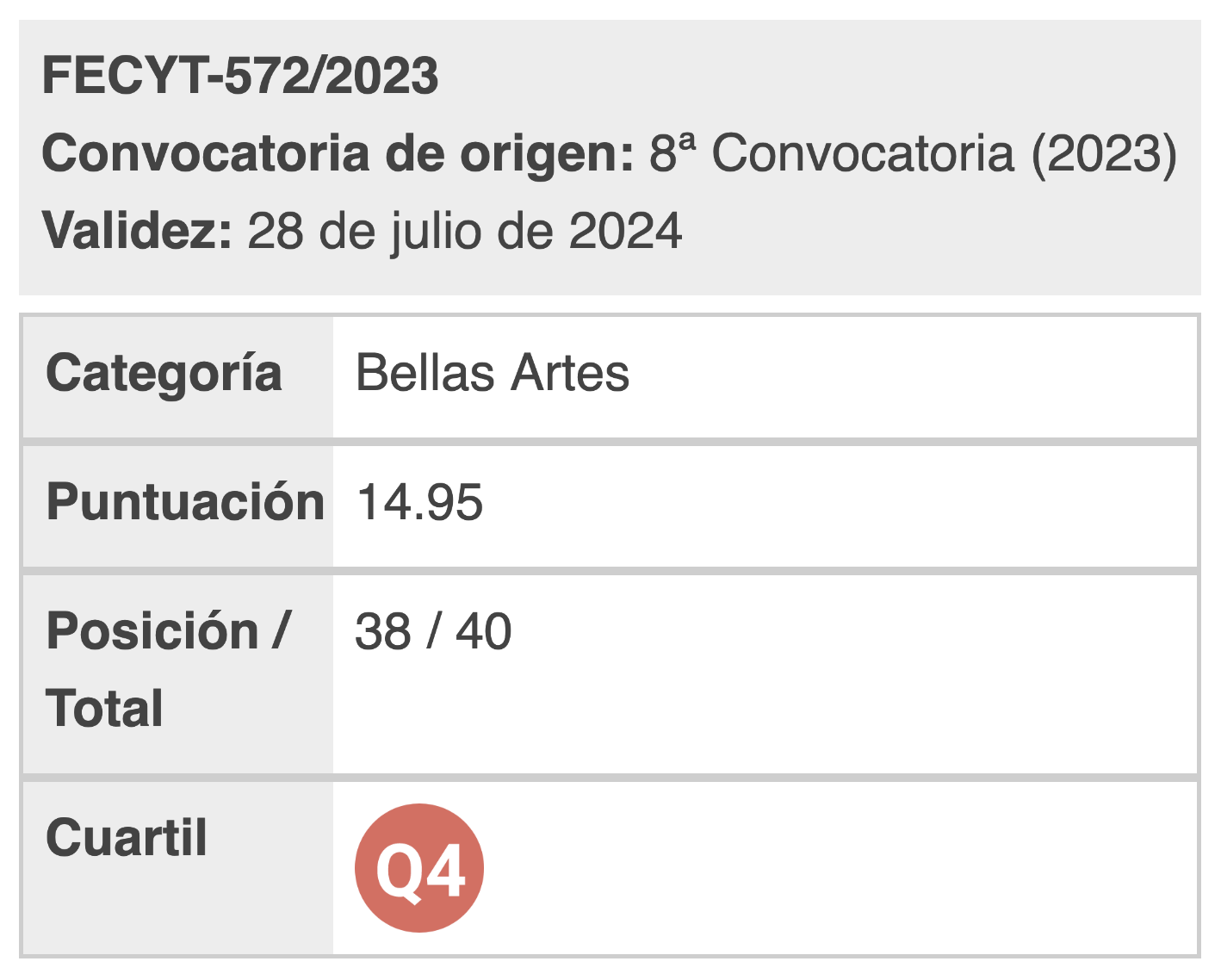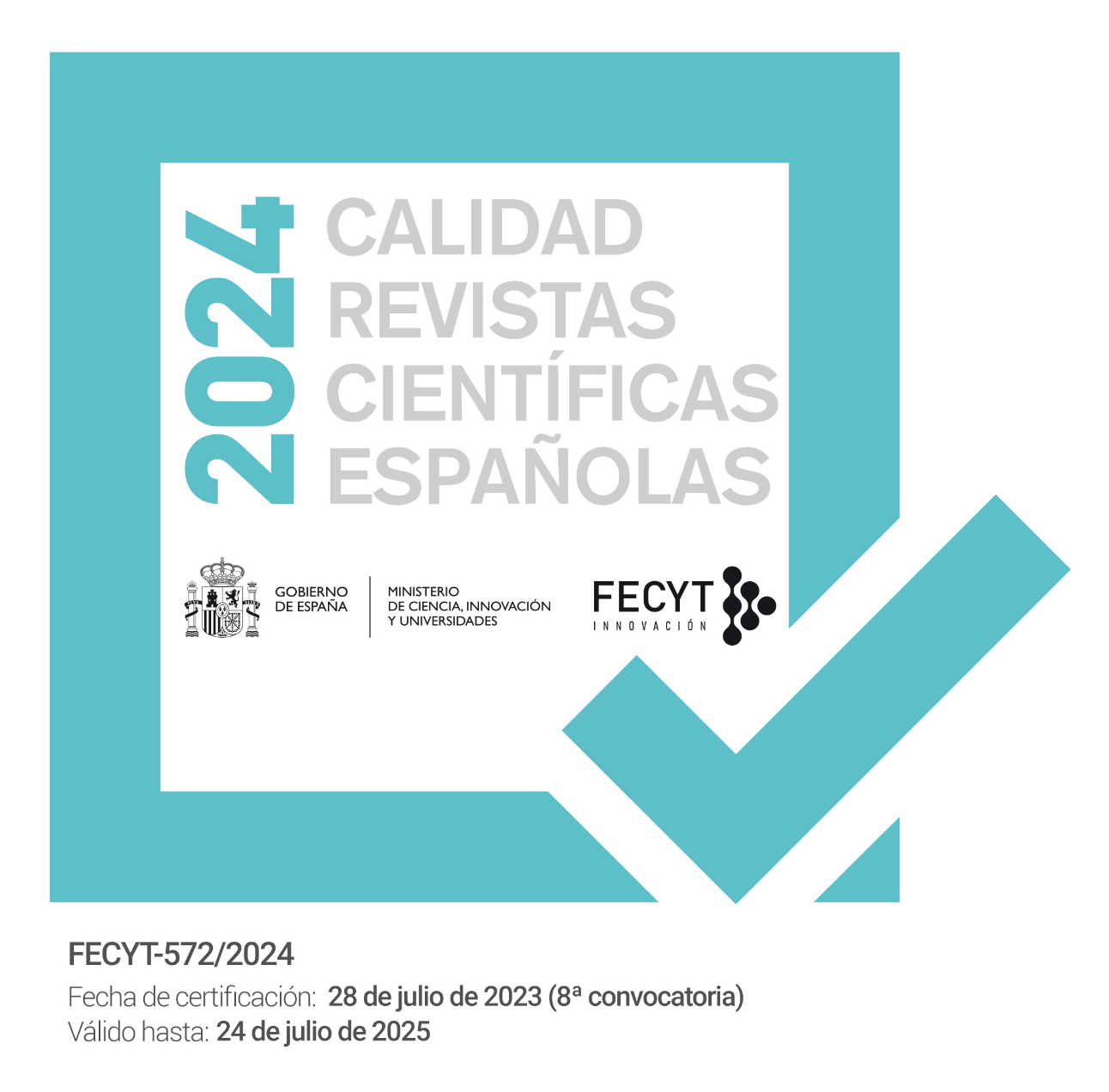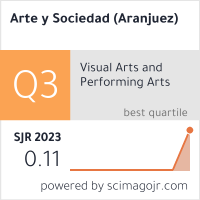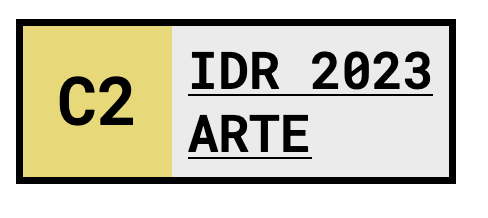Experiential structure of extended realities (XR):
Approach to the narrative from the body and its contexts.
DOI:
https://doi.org/10.5281/zenodo.7655138Keywords:
Narrative, Immersive, iteractive, Experiental, BodyAbstract
Immersive experiences have peculiarities at the receptive level that do not occur in any other artistic or communication medium. The sense of presence, the continuous interaction with the space or the first-person experience are some of them. This article intends to shed some light delving into the embodiment nature of the immersive and interactive experience creations to ultimately draw some conclusions that can serve future creators.
References
Bal, M. (2006). Teoría de la narrativa. (Una introducción a la Narratología). Ediciones Cátedra.
Borwell, D., Thompson, K. (1995). Film Art. An Introduction. Paidós.
Bourriaud, N. (2006). Estética relacional. Adriana Delgado editora.
______________ . (2007). Postproducción. Adriana Delgado editora.
Cabañes, E. (25, septiembre 2019 - 12, enero, 2020). Videojuegos. Los dos lados de la pantalla [Exposición]. Madrid: Espacio Fundación Telefónica.
Case, A. (14, noviembre, 2019). Tecnología y creatividad. Foro Telos [Conferencia]. Madrid: Espacio Fundacion Telefónica.
De Michelo, M. (2008). Las vanguardias artísticas del siglo XX. Alianza Forma.
Deleuze, G. (1984). La imagen-movimiento. Paidós Comunicación.
Ficsher-Lichte, E. (2011). Estética de lo performativo. Abada Editores.
Forrester, I. (27, junio, 2019). ¿Cómo impactar a tu audiciencia? XR FEST. [taller]. Madrid: Espacio Fundacion Telefónica.
García García, F., Gertrudix Barrio, M., Rubio-Tamayo, J. (2017, septiembre, 27). Immersive Enviroments and Virtual Reality: Systematic Review and Advanced in Communication, Interaction and Simulation. Multimodal Technologies and Interact. 1 (4), 21. Recuperado de: https://www.mdpi.com/2414-4088/1/4/21
García Selgas, F, (1994). El cuerpo como base del sentido de la acción social. En: Perspectivas en Sociología del Cuerpo. Revista española de investigaciones sociológicas. (68), 41-48. Recuperado de: https://dialnet.unirioja.es/servlet/articulo?codigo=768114
Gianneti, C. (21, enero, 2000). Arte electrónico: Ciencia, redes e interactividad. [Taller]. Badajoz: Museo Extremeño e Iberoamericano de Arte Contemporáneo. Recuperado de: http://www.artmetamedia.net/pdf/GiannettiArteCienciaRed.pdf
Giannopulu, I. (2018). Neuroscience, Robotics and Virtual Reality: Internalised vs Externalised Mind/Brain. Congnitive Computation Trends. Springer International Publishing. doi: 10.1007/978-3-319-95558-2
Granados, L. (marzo / abril, 2018). Virtual Reality and Empathy. The Humanist. 78, (2), 10-11. Recuperado en: https://thehumanist.com/magazine/march-april-2018/philosophically-speaking/ahead-curve-virtual-reality-empathy
Kandel, E. (2013) La era del inconsciente. La exploración del inconsciente en el arte, la mente y el cerebro. Paidós transiciones.
Kilteni, K., Groten, R., Slater, M. (noviembre, 2012). The Sense of Embodiment in Virtual Reality. Presence Teleoperators & Virtual Enviroments. 21, (4), 33-287. doi: 10.1162/PRES_a_00124
Lara Lara, F. (junio, 2014). La vida como narrativa: el invisible hilo que da sentido a la historia. Investigaciones fenomenológicas. 11, 251-261. Recuperado en: https://revistas.uned.es/index.php/rif/article/view/29550. DOI: https://doi.org/10.5944/rif.11.2014.29550
Macpherson, A. (23, febrero, 2018). La realidad virtual mete en la pies de sus víctimas a los maltratadores. La vanguardia. Recuperado en: https://www.lavanguardia.com/vida/20180223/44992190790/realidad-virtual-maltrato-agresores-violencia-de-genero-victimas.html
Martín Prada, J. (2012). Otro tiempo para el arte. Sendemá.
Milgram, P., Takemura, H. (1994.) Augmented Reality: A class of displays on the reality-virtuality continuum. Telemanipulator and Telepresence Technologies. 2351, 283-292. Recuperado en: http://etclab.mie.utoronto.ca/publication/1994/Milgram_Takemura_SPIE1994.pdf
Mora Fernández, J. (2009). La interfaz hipermedia. El paradigma de la comunicación interactiva. Modelos para implementar la inmersión juvenil multimedia interactivos culturales. Fundación autor.
Neurovirtualidad (2019). [Entidad]. Recuperado en: https://www.neurovirtualidad.es/
Pallasmaa, J. (2010). Los ojos de la piel. Editorial Gustavo Gil.
Pérez de Giuffré, M. (2012). Virtualidad e interactividad. Cuestiones de estética. Signos Universitarios.13, (48), 173-184. Recuperado en: https://p3.usal.edu.ar/index.php/signos/article/view/1820/2273
Pérez, P. (17, julio, 2019). Un escenario de 148.940.000 km2 presentado por MEDIAPRO. Sónar 2019 + D [taller]. Barcelona: Fira Montjuïc.
Pooper, F. (1989) Arte, acción y participación. El artista y la creatividad de hoy. Akal.
Quevedo Díaz, M. (2018). El cerebro inconsciente. Los automatismos de nuestra mente. España: EMSE EDAP.
Seo J. H. (2011) Aesthetics of Immersion in Interactive Immersive Environments: A Phenomenological Case Study of Light Strings. ISEA 2015. Recuperado en: https://pdfs.semanticscholar.org/b2c1/14d3119901c3a0c133ccc2aa7a7d9965eeb1.pdf
Tarkovki, A. (2005). Esculpir en el tiempo (7º ed.). Rialp.
The International Ergonomics Association (2015). Definition and Domains of Ergonomics. Recuperado en: https://www.iea.cc/whats/index.html

Published
How to Cite
Issue
Section
License

This work is licensed under a Creative Commons Attribution 4.0 International License.
You are free to:
Share — copy and redistribute the material in any medium or format.
Adapt — remix, transform, and build on the material for any purpose, including commercial.
Attribution — You must properly acknowledge the authorship, provide a link to the license, and indicate if any changes have been made.
You may do so in any reasonable manner, but not in any way that suggests that you endorse or receive any endorsement by the licensor for your use.
No additional restrictions — You may not apply legal terms or technological measures that legally restrict you from doing what the license allows.



























